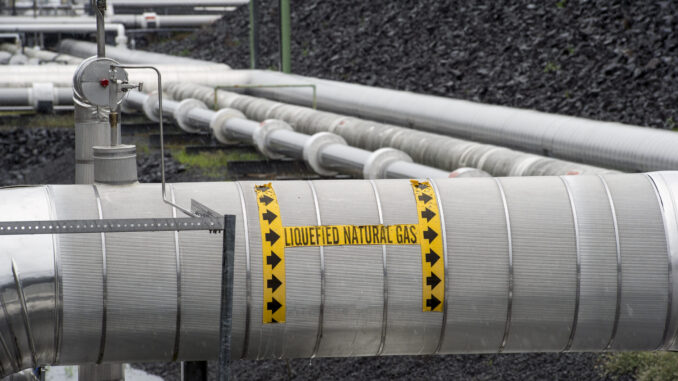
LEBANON, Pennsylvania — You may not be aware that there’s a symmetry in Pennsylvania between farmers and the natural gas industry. But just walk into the Keystone Pork, Poultry Progress and Mid-Atlantic Manure Summit here at the expo center in Lebanon County, put your hands on the propane-shaped stress ball, and you’ll start to understand it.
“Kind of tells you everything,” said Chris Herr, the executive director of PennAg Industries Association, who was holding up the merchandise everyone received when they walked into the door.

Natural gas development over the past 15 years has had a significant impact on agricultural stakeholders in this state. The partnership between two leading economic sectors in this state, natural gas and farming, has led to farmers receiving royalty payments from natural gas companies in return for leasing out the minerals found on their lands.
So when President Joe Biden announced at the end of January that he was pausing all exports of natural gas, his decision not only chilled the producers and employees in the industry, but also equally distressed American farmers. This was particularly true of those here in Pennsylvania and neighboring Ohio, where hundreds of millions of dollars last year alone went to farmers and landholders who hold leases.
Herr said this source of income for farmers in the past few years here in Pennsylvania has been a game changer, “Especially for family farms. They are now provided a source of revenue to expand their operations, or invest in new equipment or technologies, and sometimes just to save a farm on the brink.”
Jonathan Fritz, who has served in the Pennsylvania House of Representatives since 2017, said what he has seen in the rural swaths of Wayne and Susquehanna counties thanks to the natural gas industry has improved his constituents’ overall quality of life, and “It has also contributed to young people to stay here rather than move away because of new opportunities.”
In 2021, the Pennsylvania Independent Fiscal Office reported personal income growth was higher in shale-producing counties compared to non-producing counties.
The American Exploration and Production Council recently conducted a survey of Pennsylvania and Ohio gas-producing members of their trade organization to see the number of landowners receiving royalties from production on their properties — mostly farms — and then took that data and estimated the share of gas that is exported as liquid natural gas.
A royalty payment is traditionally a percentage share of the production paid from a natural gas-producing well paid to families, farmers, and landowners.
The survey omitted the billions gas companies pay in taxes, fees, and charitable contributions to state and local entities as part of calculating the scope. The eight companies who answered the survey represent 93% of Pennsylvania production and 68% of all Ohio production of natural gas for the calendar year 2023.
In Pennsylvania more than $193 million was paid to farmers and landowners due to liquefied natural gas exports, and the amount paid in Ohio to landowners was $181 million.

Herr said that money doesn’t just stay on the farm or in the family. “That money is out there being spent in the rural communities at local stores, barber shops, clothing stores, and it goes into the bigger cities where the farmer invests in new technologies and new equipment,” he said. “It is significant and it is meaningful.”
The pushback on Biden’s pause has been notable. Pennsylvania’s three major statewide elected officials, Sens. John Fetterman and Bob Casey Jr., and Gov. Josh Shapiro, all are Democrats as Biden is, but all three stridently oppose his decision.
“Everyone is looking at the impact on the industry as well as the national security, we also have to remember how it impacts our farmers and the economic opportunities they are going to lose out on,” Herr said.
“Nearly $200 million is a lot of money,” he said.
Anne Bradbury, CEO of the American Exploration and Production Council, said when America is the world leader in LNG exports, it isn’t just the people in the industry that benefit, but everyone in the country does in ways they perhaps don’t always think about.
“Not only do LNG exports strengthen our economy and our allies’ energy security, but they also provide direct financial support to families, farmers, and landowners in the form of royalty payments,” she said.
In 2023, Bradbury said more than 200,000 different recipients in Ohio and Pennsylvania received royalty payments. “And that is thanks to America’s leadership in exporting LNG. Those payments help families, revitalize communities, and generate sustainable economic growth for this region of the country.”
“Ohio and Pennsylvania lawmakers should unequivocally oppose and work to reverse the president’s LNG freeze, as their constituents’ livelihoods depend on a robust LNG export strategy now and in the future,” Bradbury said.
Source: Washingtonexaminer.com
Take the Survey at https://survey.energynewsbeat.com/
ENB Top News
ENB
Energy Dashboard
ENB Podcast
ENB Substack



